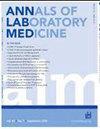Clonal Burden, Immunoglobulin Heavy Chain Variable Gene Somatic Hypermutations, and Immunoglobulin Gene Repertoire in Korean Patients with Chronic Lymphocytic Leukemia Assessed by Next-generation Sequencing.
IF 3.9
2区 医学
Q1 MEDICAL LABORATORY TECHNOLOGY
引用次数: 0
Abstract
Background We compared the immunoglobulin (IG) heavy chain (IGH) leader and FR1 primer sets to measure clone sizes and detect immunoglobulin heavy chain variable (IGHV) region somatic hypermutations (SHMs) in Korean patients with chronic lymphocytic leukemia (CLL). We also analyzed IGH and immunoglobulin kappa (IGK) to identify Korean-specific IGs in CLL. Methods Next-generation sequencing (NGS)-based gene rearrangements and IGHV SHMs were assessed in 40 patients using IGH leader, IGH FR1, and IGK primers. Flow cytometry, karyotyping, interphase FISH, and NGS-based variant analyses were performed for 165 genes. Results Clonal IGH and IGK rearrangements were detected in 100.0% and 97.5% of patients, respectively. Clonal size was generally smaller per NGS than per flow cytometry, particularly when using the IGH leader (median: 52.5%) versus the IGH FR1 primer set (73.2%). IGHV SHMs occurred in approximately 70% of patients; 10% showed primer set discrepancies. The incidence of IGHV SHMs was low in patients at high risk (i.e., with TP53 abnormalities; complex karyotypes; and ATM, NOTCH1, SF3B1, or BIRC3 variants). IGHV3 was the most common IGHV (58.3%), and IGHV4-34 was most frequently identified (14.6%). IGHV1 and IGHV1-69 usage differed significantly between Koreans and westerners. IGHJ4 was the most common IGHJ (56.3%). A single IGKV-IGKJ gene rearrangement was most frequently observed (18.9%), whereas intron-KDE was the most common rearrangement (30.6%). Conclusions NGS may underestimate CLL clonal size, particularly when using the IGH leader primer set. IGHV SHMs were inversely associated with negative prognostic factors. Our data suggest ethnic differences in CLL pathogenesis.韩国慢性淋巴细胞白血病患者克隆负担、免疫球蛋白重链可变基因体细胞超突变和免疫球蛋白基因库的新一代测序评估
我们比较了韩国慢性淋巴细胞白血病(CLL)患者的免疫球蛋白(IG)重链(IGH)先导物和FR1引物,以测定克隆大小和检测免疫球蛋白重链可变(IGHV)区体细胞超突变(SHMs)。我们还分析了IGH和免疫球蛋白kappa (IGK),以确定韩国特异性CLL的igg。方法采用新一代测序(NGS)技术对40例患者的基因重排和IGHV SHMs进行分析,采用IGK引物、ighfr1和ighk引物。对165个基因进行了流式细胞术、核型、间期FISH和基于ngs的变异分析。结果克隆性IGH重排率为100.0%,IGK重排率为97.5%。每次NGS的克隆大小通常小于流式细胞术,特别是当使用IGH先导物(中位数:52.5%)和IGH FR1引物组(73.2%)时。约70%的患者发生IGHV SHMs;10%显示引物设置差异。高危患者(即TP53异常、复杂核型、ATM、NOTCH1、SF3B1或BIRC3变异)的IGHV SHMs发生率较低。IGHV3是最常见的IGHV (58.3%), IGHV4-34是最常见的(14.6%)。韩国人和西方人对IGHV1和IGHV1-69的使用差异很大。IGHJ4是最常见的IGHJ(56.3%)。单个IGKV-IGKJ基因重排最为常见(18.9%),而内含子- kde基因重排最为常见(30.6%)。结论sngs可能低估了CLL克隆的大小,特别是在使用IGH引物时。IGHV SHMs与不良预后因素呈负相关。我们的数据表明CLL发病机制存在种族差异。
本文章由计算机程序翻译,如有差异,请以英文原文为准。
求助全文
约1分钟内获得全文
求助全文
来源期刊

Annals of Laboratory Medicine
MEDICAL LABORATORY TECHNOLOGY-
CiteScore
8.30
自引率
12.20%
发文量
100
审稿时长
6-12 weeks
期刊介绍:
Annals of Laboratory Medicine is the official journal of Korean Society for Laboratory Medicine. The journal title has been recently changed from the Korean Journal of Laboratory Medicine (ISSN, 1598-6535) from the January issue of 2012. The JCR 2017 Impact factor of Ann Lab Med was 1.916.
 求助内容:
求助内容: 应助结果提醒方式:
应助结果提醒方式:


